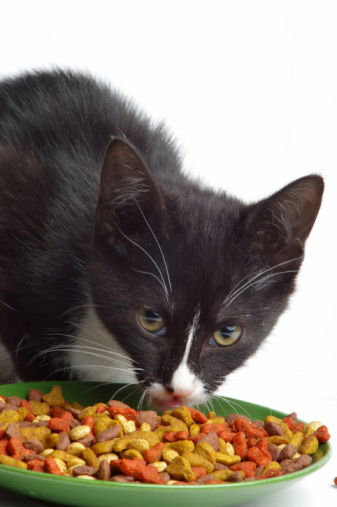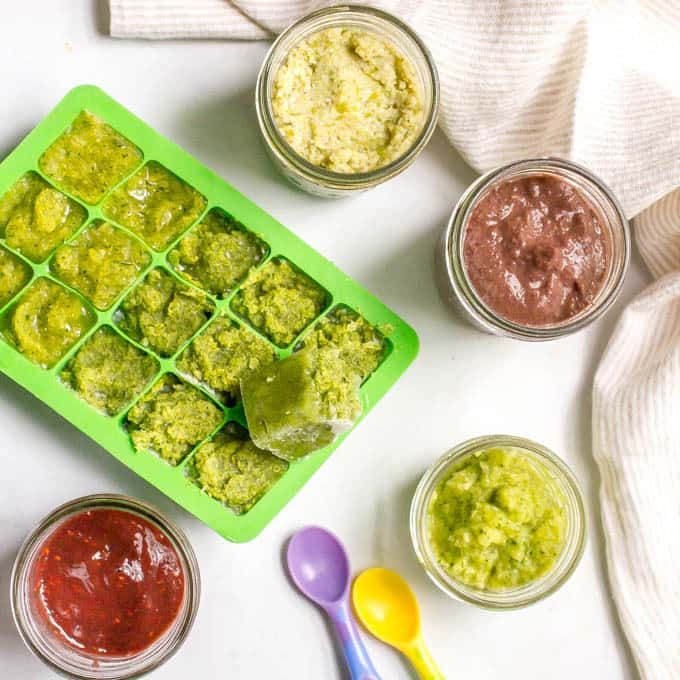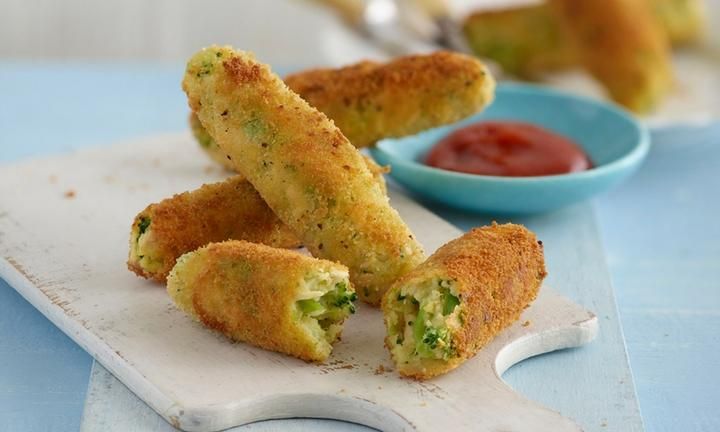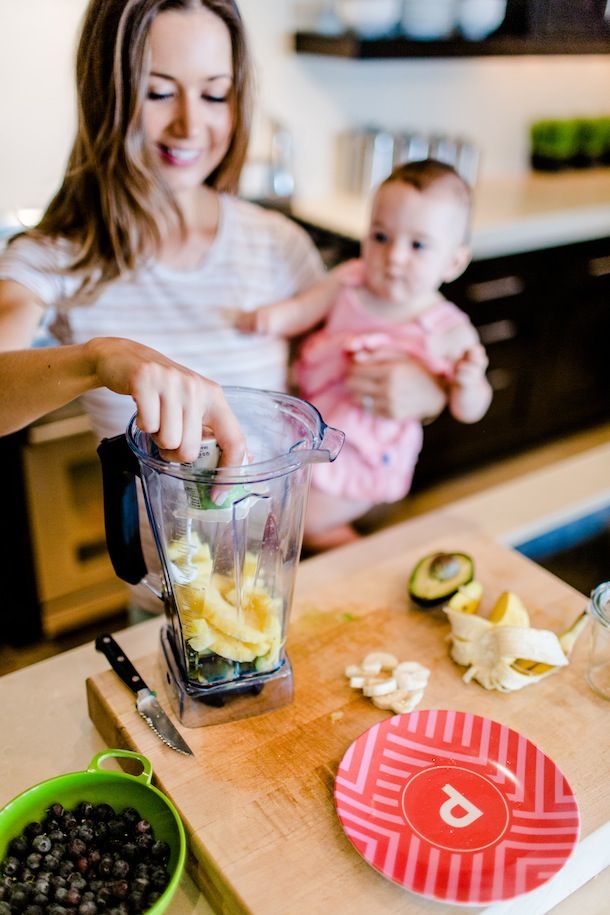When do baby kittens eat cat food
Kitten Feeding Week by Week
Image
Feeding orphaned kittens can feel like a full-time job, especially in the beginning when they need to be fed the most. But it’s also incredibly rewarding, and before you know it, your kittens will be eating on their own and soon ready to find homes. The feeding protocols below are provided by the Kitten Nursery of Salt Lake County Animal Services, in partnership with Best Friends Animal Society–Utah.
Kittens one week old or less: Bottle-feeding
- Food type: Formula
- Frequency: Every 2 – 3 hours (8 – 12 times per day)
- Amount: 3 – 4 cc per feeding
Two-week-old kittens: Bottle-feeding
- Food type: Formula
- Frequency: Every 3 hours (8 times per day)
- Amount: 5 – 6 cc per feeding
Three- to four-week-old kittens: Bottle-feeding
- Food type: Formula
- Frequency: Every 4 hours (6 times per day)
- Amount: 13 – 17 cc per feeding
Four-week-old kittens: Begin feeding gruel – Weaning stage
- Food type: 1/2 can per kitten of gruel (gruel instructions below) in a dish and dry kitten food in a dish, and dish full of water at all times.
Plus formula three times per day.
- Frequency: Keep kibble, water and gruel in cage at all times.
- Give 13 – 17 cc of formula every 8 hours (3 times per day).
- During bottle-feeding sessions, try to get the kittens to also eat gruel off a spoon or tongue depressor and from a dish (see instructions on making gruel for more tips). It is important to start getting small amounts of gruel into their stomachs.
- Note: At this time, also introduce litter box; kittens can eliminate on their own at this age and do not need to be stimulated to go anymore.
How to mix gruel
Small batch (for one kitten): ½ can of wet kitten food mixed with ¼ can of formula (use an empty food can as a measuring cup).
Large batch: Whisk 8 cans wet kitten food with 4 cans of fresh, warm formula (use the empty food can as a measuring cup). At this age, kittens like their food a little lumpy so they can chew.
Note: Substitute the warm water for formula in gruel for kittens 5 weeks and older.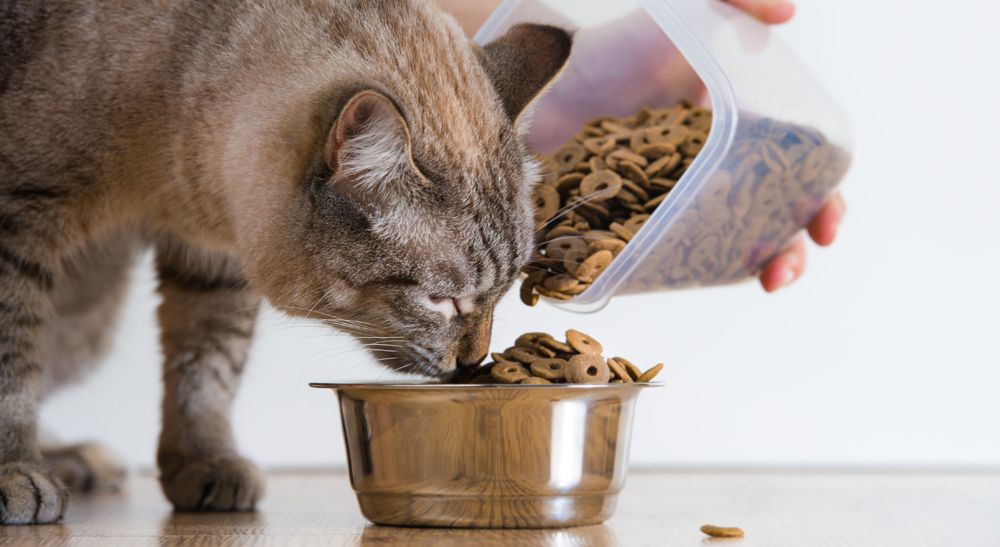
Helpful tips when using gruel:
- When introducing kittens to gruel, put gruel in a flat dish and place kittens near the dish. If they do not start to eat on their own after a few minutes, use tongue depressor or spoon to scoop gruel into kitten’s mouth. You may have to open their mouth and put a little in. You can also put a little gruel on their nose and see if they will lick it off. Sometimes the kittens need to adjust to the new taste.
- Once kitten starts to eat gruel off the spoon or tongue depressor (may take a few feedings for them to figure this step out), slowly start to lower it towards the dish of gruel. The kittens should easily transition from the spoon or depressor to the dish (may take a day for them to start eating out of the dish regularly).
- During the weaning process, kittens still need to be bottle-fed three times per day (about every 8 hours) to ensure they are receiving proper nutrients.
Five- to eight-week-old kittens: Solid food
Food type: ½ can per kitten of kibble in a dish and wet food in a dish at all times, and a dish full of water at all times
- Kittens 3 to 5 weeks should be given baby cat kibble.

- Kittens 5 to 6 weeks should be given kitten kibble and kibble should be mixed into the wet food.
- Kittens 7 weeks and older should eat mainly dry kibble.
- Weeks 5 and 6 are transition weeks where the two foods (what they were eating and what they will be eating) should be mixed together so their tummies do not get upset by the change in diet. Gradually decrease the amount of food they were eating while increasing what they will be eating over the course of 7 days.
Spay or neuter and adoption
Eight-week-old healthy kittens are fully weaned and should soon be ready to be spayed or neutered and to find their new forever homes. It is much easier to find homes for eight-week old kittens than it is if you wait longer, so start setting a plan early on. Sharing photos of the kittens with friends and family as they grow, and telling everyone you know that you’ll be looking for homes for the kittens is a great way to find homes. For more advice on finding homes for the kittens, see this guide on finding homes for homeless pets.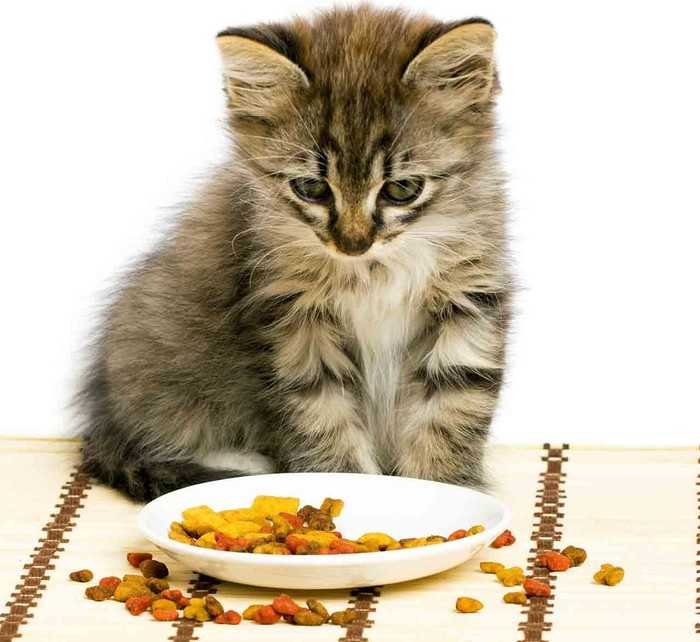
It is also important to ensure that all the kittens are spayed or neutered, so they don’t accidentally add to the thousands of unplanned litters of kittens that enter shelters each year. Find a low-cost spay/neuter clinic near you.
While caring for orphaned kittens is a lot of work, it’s also a lot of fun. The most rewarding part is watching your charges grow up and go into new homes. And the best part is that you can feel good knowing that you helped keep kittens — the most at-risk animals to enter shelters — safe and sound.
More about abandoned baby kitten care
Note: This article is the last in a four-part series on caring for baby kittens who are abandoned.
Photos by Sarah Ause Kichas
Categories:
CatCaring for Pets
When can kittens start eating solid food?
Search blog
All articles News Vet clinic Life as vet Ask a vet Dogs Cats
If there is one thing that we can all agree on, it is that kittens are insanely cute.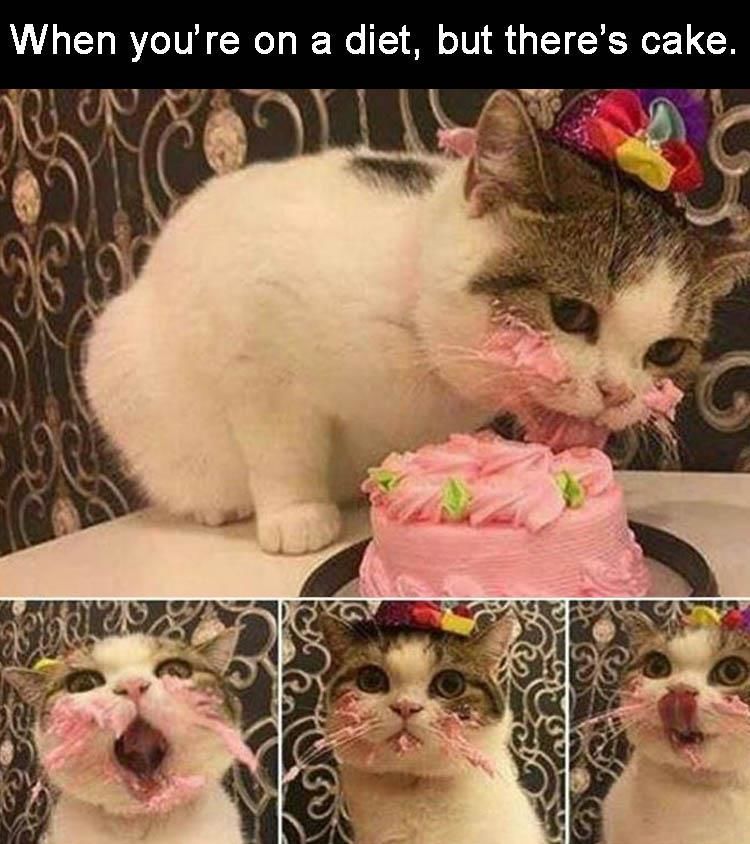 Those of us lucky enough to have their homes overrun by the little critters will be very aware of the responsibility to ensure that they get the best care. A crucial part of this is successfully weaning them from milk onto solid food. The Cats Protection League survey in 2020 found that 16% of all neutered female cats have one litter before they are spayed. Given there are 5.3 million owned female cats in the UK, that equates to a lot of kittens that need to be weaned onto solids. So, whether breeding was intended, or the kittens were an accident, knowing when to start weaning them onto solid food is essential for giving a kitten the best start in life.
Those of us lucky enough to have their homes overrun by the little critters will be very aware of the responsibility to ensure that they get the best care. A crucial part of this is successfully weaning them from milk onto solid food. The Cats Protection League survey in 2020 found that 16% of all neutered female cats have one litter before they are spayed. Given there are 5.3 million owned female cats in the UK, that equates to a lot of kittens that need to be weaned onto solids. So, whether breeding was intended, or the kittens were an accident, knowing when to start weaning them onto solid food is essential for giving a kitten the best start in life.
Table of contents
- What is the meaning of “weaning”?
- Kittens are ready to try solid foods at 4 weeks old.
- What are the pitfalls to watch out for?
- Is the timing of weaning different for hand-rears?
- You might also be interested in:
What is the meaning of “weaning”?
The Oxford English Dictionary defines weaning as to “accustom (an infant or other young mammal) to food other than its mother’s milk”.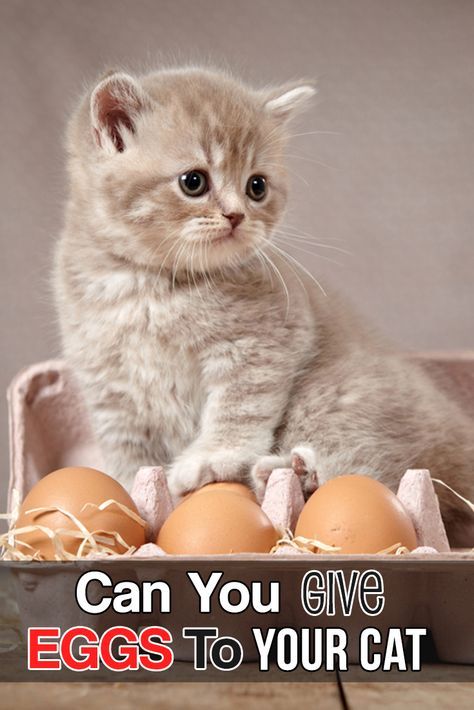 There is a second definition, which when talking about baby animals, is often conflated with the first: “accustom (someone) to managing without something which they have become dependent on”. In this context, removing the kitten permanently from the mother. This confusion is unfortunate as it suggests that kittens (and other baby animals) should be removed from their mothers when they start eating solid food. In fact, a kitten should remain with the mother at least a month after they have started eating solid food to ensure adequate socialization.
There is a second definition, which when talking about baby animals, is often conflated with the first: “accustom (someone) to managing without something which they have become dependent on”. In this context, removing the kitten permanently from the mother. This confusion is unfortunate as it suggests that kittens (and other baby animals) should be removed from their mothers when they start eating solid food. In fact, a kitten should remain with the mother at least a month after they have started eating solid food to ensure adequate socialization.
“Early weaning”, as in early separation from the mother, can result in behavioural problems. It can be a challenge in hand-reared kittens. However, here we discuss weaning in strictly the sense of introducing a kitten to solid food.
Kittens are ready to try solid foods at 4 weeks old.
Weaning a kitten from a 100% milk diet to solid food is a delicate business. Some kittens might start showing interest in their mother’s food from 3 weeks of age. Most will be ready to be introduced to kitten gruel by 4 weeks of age. At this stage, you should be actively encouraging kittens to eat solid food. Kitten gruel is a mash of high-quality kitten food mixed with kitten replacement milk formula. It is designed to be easy for the kitten to lap up.
Most will be ready to be introduced to kitten gruel by 4 weeks of age. At this stage, you should be actively encouraging kittens to eat solid food. Kitten gruel is a mash of high-quality kitten food mixed with kitten replacement milk formula. It is designed to be easy for the kitten to lap up.
As kittens get used to the gruel, the amount of milk added can be reduced gradually. It helps to serve the gruel in a flat dish. Such as a saucer or even an upside-down Tupperware lid if there is one to spare. This allows easy access to the food. Expect feeding to be very messy for the first few days. But most kittens should complete the transition to kitten food by 6 weeks of age.
What are the pitfalls to watch out for?
Just like human babies, kittens develop at different rates. So whilst some may be chowing down their gruel in no time, they may have siblings who are struggling to get the hang of things. It may simply be that they need more time to get used to solids. Still, it is a good idea to weigh all kittens daily to pick up any problems early. Even if they are still nursing from their mother. A healthy kitten should gain at least 10 grams a day. If, after introducing solids, the kitten’s weight gain curve flattens or they become dull and lethargic, that is the cue to take the little one for a checkup with the vet to see if an underlying cause can be identified.
Even if they are still nursing from their mother. A healthy kitten should gain at least 10 grams a day. If, after introducing solids, the kitten’s weight gain curve flattens or they become dull and lethargic, that is the cue to take the little one for a checkup with the vet to see if an underlying cause can be identified.
Is the timing of weaning different for hand-rears?
Unfortunately, no. After several weeks of relentless night feeds, the temptation to get the little darlings onto solids earlier is understandable. Nevertheless, the magic age for introduction to solids for hand-reared kittens is still 4 weeks and certainly not before 3 weeks of age.
You might also be interested in:
When can a kitten be given dry food
The appearance of a new friend in the family is always happiness. A small lump brings warmth and comfort to the house, as well as an important question: how to feed a kitten? You need to monitor the nutrition of the baby from the first days of life.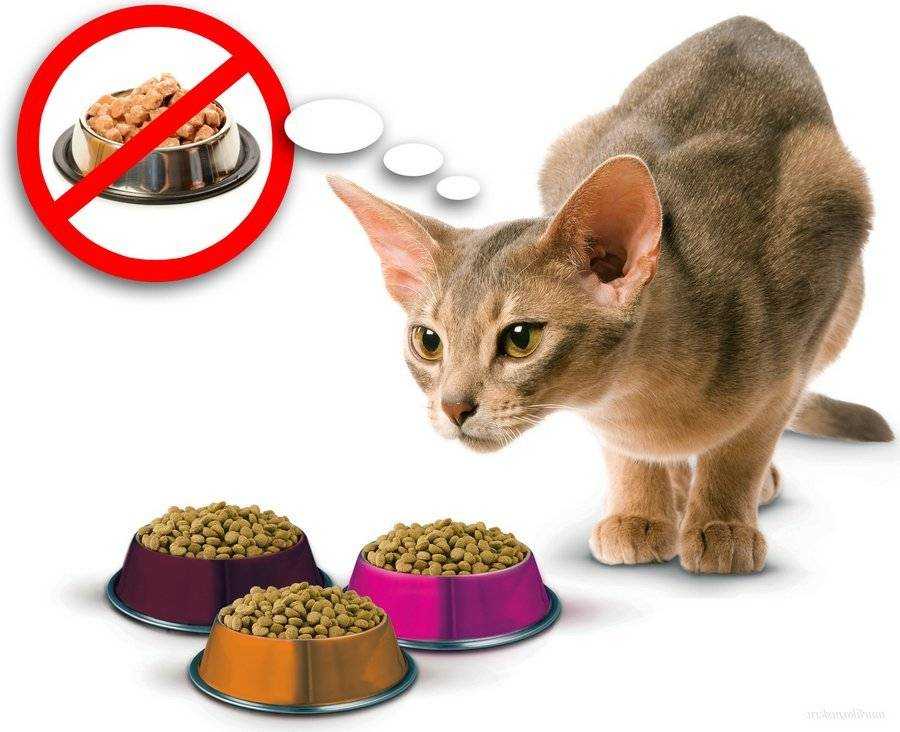 And the most crucial moment is the transition of the kitten from wet food to dry food.
And the most crucial moment is the transition of the kitten from wet food to dry food.
After birth, the mother takes care of the nutrition of the kitten. Colostrum, and later mother's milk, is a natural and healthy food for kittens up to 2 - 2.5 months. Cat's milk contains twice as much fat as cow's milk, and contains about three times more protein. With such nutrition, the kitten will receive everything necessary for healthy growth and development.
If for some reason the cat does not have the opportunity to feed the litter, or there is not enough milk, there are worthy analogues in pet stores. The sucking reflex in a kitten appears even in the womb, so any responsible owner will be able to feed the kitten on their own. Veterinarians do not recommend preparing a nutrient mixture for a kitten yourself, because the kitten's digestive system is sensitive, and immunity is just beginning to form. ROYAL CANIN Babycat Milk is suitable for kittens from the first birthday up to 2 months. It comes with a feeding bottle and instructions. With this kit, you can feed your kitten up to 1-2 months before switching to dry food.
It comes with a feeding bottle and instructions. With this kit, you can feed your kitten up to 1-2 months before switching to dry food.
Complete transition to dry food is possible after 2 months from the date of birth of the kitten. However, the transition requires careful preparation. The first, still milk incisors, appear in kittens for 2-3 weeks of life. At 3-4 weeks, fangs appear in kittens. From now on, you can add dry food to your little pet's diet. At this time, it serves only as an addition to the main diet, so that the kittens get used to solid food. It is not necessary to soak the food in water or milk, even the milk teeth of a kitten will perfectly cope with this food. The only important point is the size of the croquettes. Dry food should be just for kittens. You can not give the kitten food for adult cats, because it can simply choke on large granules. Not to mention, the nutritional needs of kittens and adult cats are different.
If the kittens show no interest in dry food, you may need to wait a little longer. The decisive signal will be the moment when the kittens begin to gnaw on the surrounding objects. This is a natural reflex that helps kittens explore the world. From this period, you can definitely start the transition to a new, dry kitten food.
The decisive signal will be the moment when the kittens begin to gnaw on the surrounding objects. This is a natural reflex that helps kittens explore the world. From this period, you can definitely start the transition to a new, dry kitten food.
Choosing the right dry food for a kitten
In every pet store you can find lines for adult cats and lines for kittens. The rulers are divided among themselves for good reasons: the size of the granules and the energy value.
Despite their modest size, a kitten needs more energy than an adult cat. Up to a year, a kitten's skeleton is formed, muscle mass grows, teeth are renewed and immunity is established. Babies are generally more active and mobile. All this requires energy, which the little fidget receives from the feed. On average, a kitten needs 25% more calories than an adult cat. If you feed a kitten with adult cat food, he may experience a lack of energy. As a result, problems with the formation of the skeleton, teeth, immunity or muscle mass. Therefore, in the first months of life, the kitten should eat special food.
Therefore, in the first months of life, the kitten should eat special food.
However, there are exceptions - Super Premium and Holistic. Many of these diets can be included in the diet from 2-3 months. So, for example, GO food can be given to a kitten from 2 months of age. A lower calorie content in this case is solved by increasing the portion for the kitten, according to the feeding norms. But why not do this with economy and premium food? It's all about the calorie sources. In premium feeds, meat occupies up to 20% of the composition. The rest of the feed can be vegetables and cereals. With an increase in the volume of a portion of the economy segment feed, the pet will eat more cereals, and only a little more meat. Such a diet is contraindicated for a baby whose body is just being formed. At the same time, Akana feeds contain up to 60% meat, and legumes serve as a source of carbohydrates in them. This food is biologically compatible with the cat's natural diet.
The composition will help you determine if a given food is right for your kitten. Earlier we wrote about what modern feeds consist of and how they are produced. The principles for selecting ingredients in kitten food are the same as for adult cats. The special needs of a kitten include an increased protein content. Make sure that the meat in the composition goes on the first line. It is also recommended to avoid foods that contain by-products and meat ingredients, indicated in general terms, without a percentage. For example, the line "meat and offal of animal origin" should alert the responsible owner. If the manufacturer included lamb fillet in the feed, he would openly write about it. The silence of the ingredients suggests that the meat in the feed is far from being of the highest quality. If for an adult cat such a diet can be called acceptable, then the kitten's weak digestive system may not be able to cope with the digestion of offal. From here, the kitten may have vomiting and problems with the stool.
Earlier we wrote about what modern feeds consist of and how they are produced. The principles for selecting ingredients in kitten food are the same as for adult cats. The special needs of a kitten include an increased protein content. Make sure that the meat in the composition goes on the first line. It is also recommended to avoid foods that contain by-products and meat ingredients, indicated in general terms, without a percentage. For example, the line "meat and offal of animal origin" should alert the responsible owner. If the manufacturer included lamb fillet in the feed, he would openly write about it. The silence of the ingredients suggests that the meat in the feed is far from being of the highest quality. If for an adult cat such a diet can be called acceptable, then the kitten's weak digestive system may not be able to cope with the digestion of offal. From here, the kitten may have vomiting and problems with the stool.
When choosing a dry diet for a kitten, it is better to immediately think about what brand of food you want to feed your pet in the future. Indeed, upon reaching one year, the kitten will have to switch to food for adult cats. Lines of 90% of manufacturers have food for both adults and kittens. The transition between two lines is easier if they are the same brand of food.
Indeed, upon reaching one year, the kitten will have to switch to food for adult cats. Lines of 90% of manufacturers have food for both adults and kittens. The transition between two lines is easier if they are the same brand of food.
How to accustom a kitten to new food
The basic principle is simple - you need to smoothly introduce dry food into the kitten's diet, observe the results and increase the amount of dry food in the diet. Carefully monitor the reaction of the kitten's body and adjust the diet in accordance with it. So the pet can easily switch to dry food.
What happens if you completely replace the diet with dry food?
A kitten can completely switch to dry food only after reaching a certain age. As a rule, it is 2-3 months. The food itself, to which the pet passes, is also important. It must be complete.
It is not recommended to transfer a kitten under 2 months to dry food, even if you soak it with water.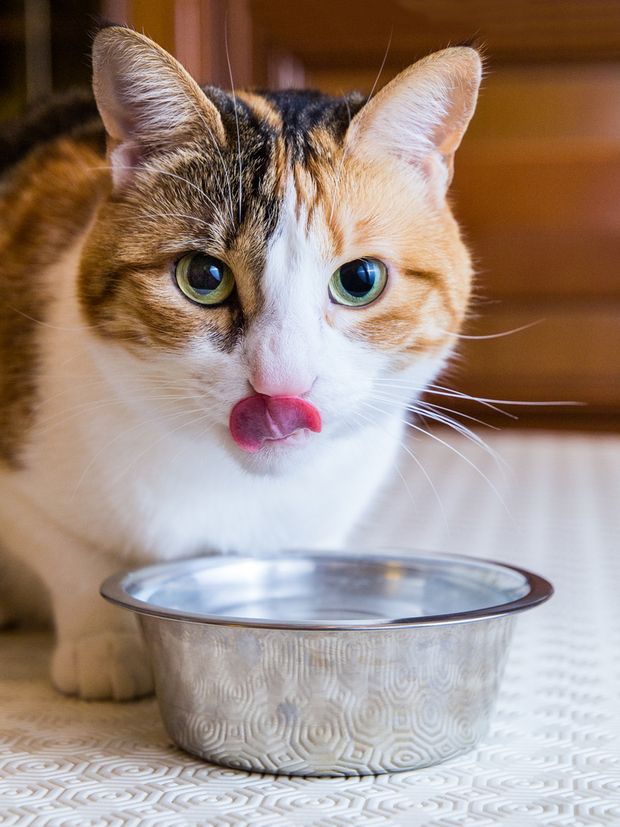 It's all about the needs of the kitten during this period. Until 2 months old, a kitten needs a lot of energy from food. He can get it from his mother's milk or kitten formula. Both those and others contain much more protein and fat as a source of energy. If the kitten switches to dry food before the end of the feeding period, he may have developmental problems.
It's all about the needs of the kitten during this period. Until 2 months old, a kitten needs a lot of energy from food. He can get it from his mother's milk or kitten formula. Both those and others contain much more protein and fat as a source of energy. If the kitten switches to dry food before the end of the feeding period, he may have developmental problems.
A kitten that has reached the age of two months can be safely transferred to a complete dry food diet. It contains enough nutrients for a full life and growth. The main thing is that the food is formulated specifically for kittens, or, in the case of holistics, shown to kittens from two months of age. Also, you can not transfer the kitten to dry food in one day. This process requires attention and should be carried out for at least a week. It is necessary to gradually introduce dry food into the feed ration and reduce the number of milk intakes.
“There is an opinion that ready-made diets, in particular dry food, somehow stimulate the appearance of urolithiasis.
Actually it is not. On the contrary, ready-made diets are balanced in terms of the content of proteins, fats, minerals, microelements and are aimed at preventing urolithiasis,” Vasily Shilov, Candidate of Veterinary Sciences.
Modern dry food does not cause dehydration or digestive problems. They don't need to be soaked. The main thing is that the cat has constant access to a bowl of water. Therefore, after reaching two months, you can safely switch to only dry food.
« High-quality dry food contains a lot of meat or fish, a balanced complex of vitamins and minerals, taking into account the age and health of the animal. This food is suitable as a permanent diet, and there is no need to add canned food to it”,
– Vastab PetCity clinic veterinarian Rannamõisa Marja Roosileht.
However, to diversify the diet, you can periodically include wet food in his diet. It's great if the brands of your dry and wet food are the same. If the manufacturer that produces the line of dry food does not have a wet food, look towards super-premium and holistic wet food. As a rule, they are 60-80% meat and will not harm the pet.
It's great if the brands of your dry and wet food are the same. If the manufacturer that produces the line of dry food does not have a wet food, look towards super-premium and holistic wet food. As a rule, they are 60-80% meat and will not harm the pet.
PlanetaZOO recommends
The choice of dry food for a kitten depends on its growth and further development. A small organism is sensitive to nutrition, and therefore the choice of food should be approached with all responsibility. A selection from Planet ZOO will help you navigate among manufacturers and not get confused when choosing food in pet stores.
1. Mr. Buffalo
Premium complete food. The main source of protein in the feed is chicken meat (36%), and carbohydrates - whole grain rice. The food strengthens the immunity of babies, increases resistance to diseases. B Due to the high meat content, the food is easy to digest and assimilate, has excellent taste and is suitable even for picky pets.
2. Brooksfield
Super premium food from sunny Italy. As part of 57% of meat ingredients, hypoallergenic rice acts as a source of carbohydrates. The food is rich in vitamins due to the addition of fruits and vegetables. Suitable for both pregnant cats and kittens from one month old. It turns out that by buying a large pack you can feed both mother and kitten. A good option in terms of price - quality.
3. Royal Canin
Premium food with the widest range for babies. Babycat Milk is a milk that can be given to a kitten from birth up to 2 months. Mother & Babycat (mousse) wet food, 2 to 4 months. Dry food of the Kitten series, for feeding kittens up to a year. Thanks to a wide range of products, you will be able to smoothly transfer a kitten from a wet type of food to a dry one. This is the brand of food recommended by most breeders.
4. Karmy
Premium food from Russia. Promotes a healthy and improved digestive system, allowing your kitten to grow up strong, active and healthy.
What to give to kittens - Purina.ru
How to feed a kitten just weaned from its mother? When to switch to adult food? And what happens if you feed the baby cow's milk and fresh meat? We tell you what to give kittens from 0 to 12 months and how to introduce the first complementary foods without harm to the digestive system.
Where to start
To build a balanced diet and decide on a feeding schedule, you need initial data: the exact age of the kitten and information about what it was fed before.
If the pet came straight from the breeder, all information, including weight gain schedule, can be obtained from him. The most optimal age for weaning from the mother is 2-3 months. At this point, the animal is already eating solid food and has primary immunity obtained through the mucous membrane of the stomach and intestines with mother's milk.
For the first 7-10 days in the new home, the kitten is fed the same as in the cattery, and the animal is monitored so that the animal does not overeat. This is due to the already developed set of enzymes necessary for the digestion of food. If you introduce a new food one day, the body will not have time to rebuild, and will react with vomiting and violation of the stool, up to an emergency call to the veterinarian. Therefore, new products should be introduced gradually, offering them first for testing, and then mixing them with the old food in a ratio of 1:5, where a smaller part is allocated to the new, and a large part to the old. Then 2:4, 3:3 - and so on until the new food completely replaces the old one. The average time to switch from old food to new food is 7 to 14 days.
This is due to the already developed set of enzymes necessary for the digestion of food. If you introduce a new food one day, the body will not have time to rebuild, and will react with vomiting and violation of the stool, up to an emergency call to the veterinarian. Therefore, new products should be introduced gradually, offering them first for testing, and then mixing them with the old food in a ratio of 1:5, where a smaller part is allocated to the new, and a large part to the old. Then 2:4, 3:3 - and so on until the new food completely replaces the old one. The average time to switch from old food to new food is 7 to 14 days.
If the pet is picked up on the street and the exact age is not known, the animal must be taken to the veterinarian. But if the kitten's condition is critical and there is no time left to go to the clinic, it is permissible to feed the baby with rice decoction, cat's milk substitute from a pet store, or, in extreme cases, infant formula. These foods are safe for kittens even in their first week of life and will not cause indigestion.
Is it possible to give milk to a kitten
Feeding undiluted milk to a kitten is dangerous for its digestion. Whole cow's milk causes upset stools and severe dehydration in kittens. This is due to immunity to milk sugar (lactose). It forms a sticky mass (casein) in the stomach and is not digested, causing bloating and colic. But even with the relative acceptance of an atypical diet, there will be less nutrients and the animal will develop more slowly.
Below is a table with a detailed analysis of cow's and cat's milk in terms of protein, fat and carbohydrate balance:
| Composition | Cat milk | Cow's milk |
| Water | 82.4 | 87.4 |
| Lactose | 4.8 | 4.8 |
| Proteins | 7.0 | 3.3 |
| Fats | 4.8 | 3.8 |
Table 1
When to introduce the first complementary foods
According to veterinary practice, a cat feeds kittens for 40-60 days. This period is needed to build immunity, which will reduce the body's susceptibility to infectious and viral diseases that the animal will face in the future. So at what age should we introduce complementary foods?
This period is needed to build immunity, which will reduce the body's susceptibility to infectious and viral diseases that the animal will face in the future. So at what age should we introduce complementary foods?
In the first month of life, it is not necessary to introduce complementary foods. All nutrients come from mother's milk and the cubs have enough of it. However, if this is a multiple litter, where stronger and stronger individuals push the weak ones aside and there is not enough milk for everyone, or the kittens are taken away from the mother too early, the babies will have to be fed from the first days of life. The main thing is to monitor the dynamics of weight gain and avoid overfeeding.
There are two ways to make up for the lack of mother's milk: find a cat-nurse or transfer the animal to artificial mixtures. You can find a recently born cat through a veterinarian or special forums on the Internet. However, not every animal will accept someone else's cub and will not harm him, especially if he smells someone else's smell from him.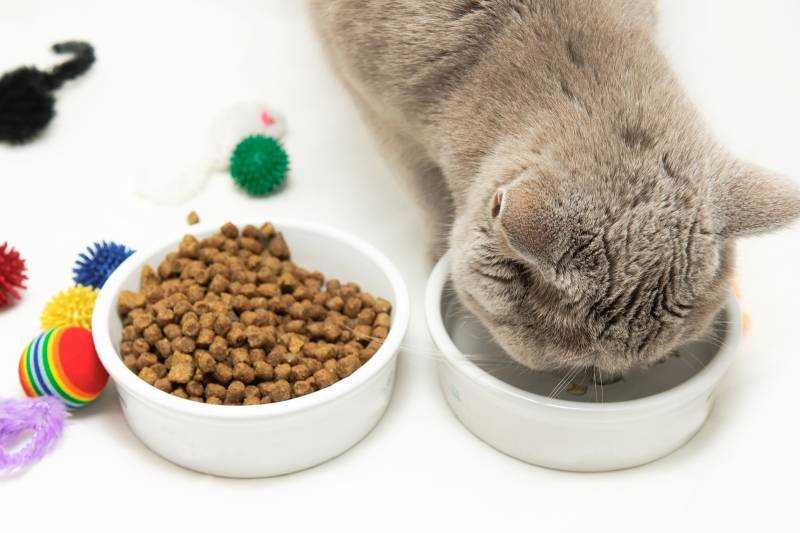 Therefore, it will be easier to switch to artificial feeding.
Therefore, it will be easier to switch to artificial feeding.
You can feed your baby with a cat's milk replacer - it is available in powder or liquid form. The main thing is not to confuse it with lactose-free milk for adult cats. It's not the same thing.
Starting from the 8th day of life, the animal can absorb liquid vitamins, which are injected into the mouth with a syringe without a needle. A veterinarian will help you choose a vitamin complex.
If the kitten has indigestion when a new food is introduced, dilute the mixture with water or add a few tablespoons of chamomile decoction. If the condition does not stabilize, drugs with bifidobacteria are used.
From the age of 3-4 weeks, the kitten is ready for the first feeding with semi-solid food. You can feed both industrial and natural food. The choice depends on the wishes of the owner. But whatever they are, the main thing is not to mix feed with each other. This will lead to an imbalance of nutrients and disruption of the digestive system.
If natural, all ingredients must be fresh and preferably from the same manufacturer. The daily serving size should not exceed 120-130 g, of which 60% is reserved for proteins, 10% for fats and 30% for carbohydrates.
The list of permitted products includes: low-fat cottage cheese, cereals in milk broth, lean soups and egg yolk. When adding meat, the piece should be lean, brought to a puree state. Adding spices and sugar is strictly prohibited.
If fed commercially, kitten pâtés diluted with water or formula are suitable. The daily energy requirement is already calculated by the manufacturer. A kitten eats 1-2 sachets a day.
The list of permitted foods includes: premium or super-premium wet food. High-quality food is supplied without salt, dyes, flavor enhancers and aromatic additives.
To permanently transition a kitten from milk formula to semi-solid food, it is necessary to gradually increase the proportion of new products, alternating milk and complementary foods with each other or mixing them together.
From the age of 2-4 months, the kitten is ready to eat solid food. The pieces should be small, but dense enough for the animal to learn to chew and strengthen the jaw muscles.
If natural food is given, the list of allowed products will be replenished with boiled vegetables, low-fat sea fish (hake, haddock, cod), germinated wheat and oat sprouts, cereals and fermented milk products (kefir, yogurt, low-fat cottage cheese). Serving size increases to 160-180 g.
If fed commercially, dry premium and super premium kitten food with a minimum kibble size will do. High-quality feed should be high-energy, high in protein and calcium. On the day the kitten eats 40-50 g of dry food, 2-2.5 sachets of wet food or 15-30 g of dry food mixed with 1 sachet of wet food.
To get the kitten interested in solid food, it is soaked in water. This is necessary to give the food a familiar texture and enhance the smell.
If the animal has switched to solid food without complications, the diet remains the same.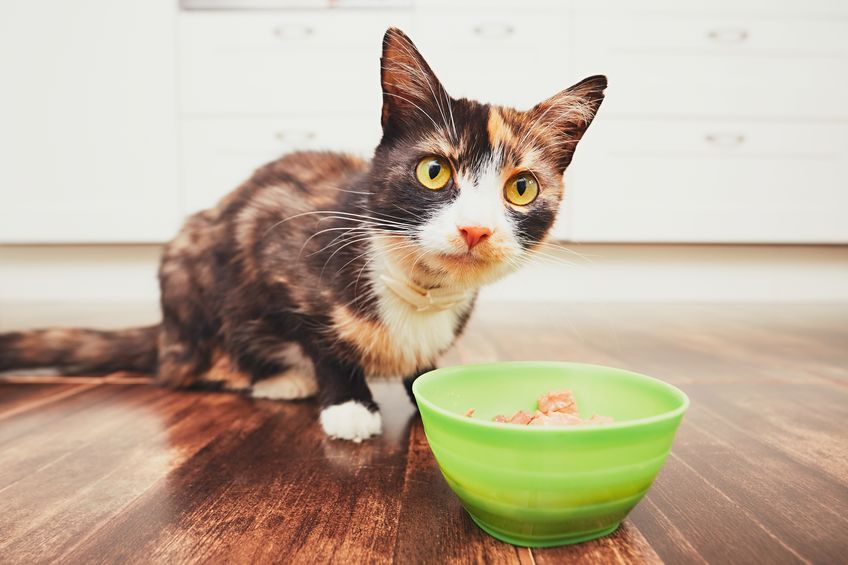 Only the portion size increases.
Only the portion size increases.
If fed natural, serving size is determined according to current energy requirement (see Table 3). The average daily serving size is 180-240 g.
If industrial feed, in accordance with the manufacturer's instructions. Usually a kitten eats 50-65 g of dry food, 2.5-3 sachets of wet food or 30-45 g of dry food mixed with 1 sachet of wet food.
By the first half of the year, the pet can switch to adult foods and adult serving sizes.
Cats are transferred to the adult line as early as 6 months. They grow and develop faster. Kotov - a little later. They reach adult size more slowly.
Normal kitten weight
The average weight gain in the first year of life can be tracked in Table 2. If the animal gains weight more slowly or, on the contrary, overeats, a consultation with a veterinarian is necessary. It is likely that the food is too heavy or does not contain enough nutrients for active growth.
| Age | Average kitten weight |
| 1 week | 113 g |
| 2 weeks | 200 g |
| 3 weeks | 280 g |
| 4 weeks | 370 g |
| 2 months | 700-1500 g |
| 3 months | 1480-1790 |
| 4 months | 1880-2400 g |
| 5 months | 2290-2900 g |
| 6 months | 2550-3390 g |
| 7 months | 2620-3750 g |
| 8 months | 2700-4000 g |
| 9 months | 2800-4100 g |
| 10 months | 2810-4200 g |
| 11 months | 3000-4350 g |
| 12 months | 3150-4400 g |
Table 2
Daily energy requirement of a kitten
calories.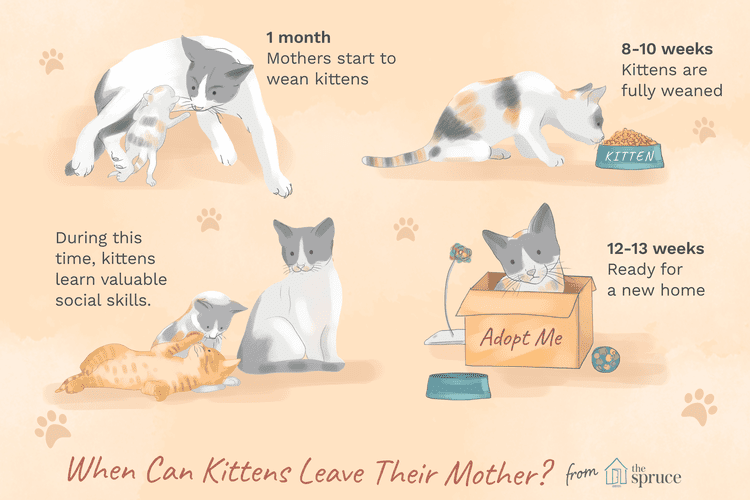 If for industrial feed - compare the values \u200b\u200bfrom the table with the information on the back of the package.
If for industrial feed - compare the values \u200b\u200bfrom the table with the information on the back of the package.
When feeding with prepared food, all calculations are made by the manufacturer. It remains for the owner to measure the portion in accordance with the current weight of the animal and introduce a new food with the transition to a new age group.
| Age | J | Kcal |
| Up to 8 weeks | 628 | 151 |
| Up to 3 months | 837 | 200 |
| Up to 6 months | 963 | 230 |
| 3 kg cat | 1005 | 240 |
| 4 kg cat | 1340 | 320 |
| 5 kg cat | 1465 | 350 |
Table 3
How to set up a feeding schedule
For general serving size recommendations, see the back of the food package. But for most kittens, the feeding schedule is as follows:
But for most kittens, the feeding schedule is as follows:
| Age | Mix temperature | Feeding mode |
| 1-7 days | 38 degrees | 10-12 times a day (every 2 hours) |
| 7-14 days | 38 degrees | 10 times a day (every 2.5 hours) |
| 14-21 days | 30-32 degrees | 8-10 times a day (every 2.5-3 hours) |
| Day 21-30 | 28-30 degrees | 8 times a day (every 3 hours) |
| 30 days | 24-26 degrees | 6-8 times a day (every 4 hours) |
| 1-3 months | 15-25 degrees | 6 times a day (every 4-5 hours) |
| 4-5 months | 15-25 degrees | 4-5 times a day (every 5 hours) |
| 6-9months | 15-25 degrees | 3-4 times a day (every 6 hours) |
| 9-12 months | 15-25 degrees | 1-2 times a day (every 8 hours) |
How to feed a newborn kitten
For the first 8 days of life, the weight of a kitten should double.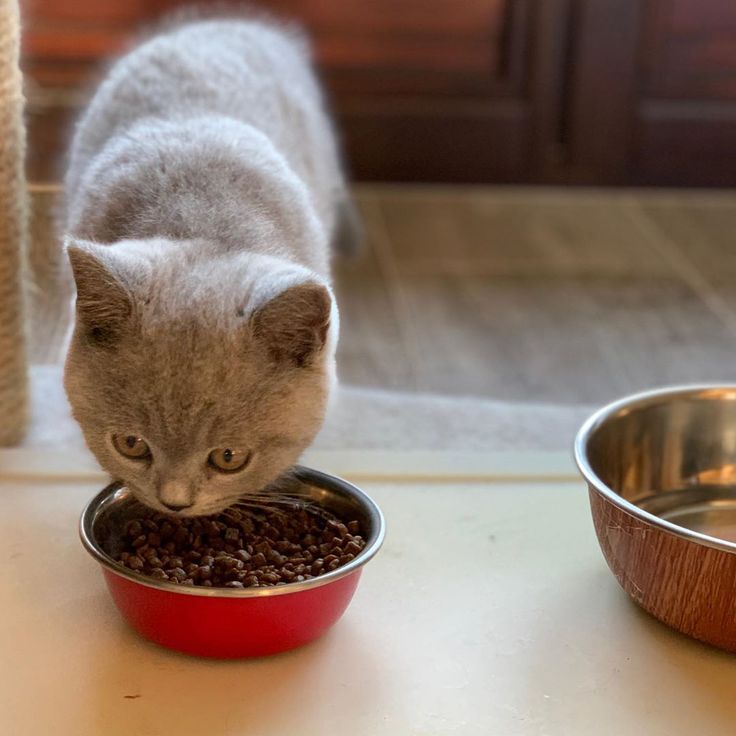 A healthy individual sucks milk up to 10-12 times, taking up to 3 hours to absorb food. The rest of the time the animal spends on sleep and active growth.
A healthy individual sucks milk up to 10-12 times, taking up to 3 hours to absorb food. The rest of the time the animal spends on sleep and active growth.
If the kitten is full, it sleeps peacefully and behaves quietly. If hungry, it lets out a squeak, crawls uneasily along the nest and sucks the outstretched finger.
To feed a newborn kitten, follow the instructions:
A newborn kitten can eat from a syringe without a needle or eye drops. But it is preferable to purchase a special bottle with an anatomical nipple. It will help develop the sucking reflex and strengthen the jaw muscles. In addition, the baby will eat exactly as much as he can, and will not choke.
Keep the teat opening narrow. Otherwise, the baby may choke and inhale the liquid into the lungs.
Newborn kitten food should be warm (38 degrees) and sterile. The bottle and nipple should be sterilized in a steam sterilizer - just like bottles for newborns - or treated with cold sterilization liquid. Heat the food in a water bath - if you use a microwave oven, the liquid warms up unevenly, and the kitten may burn itself.
Heat the food in a water bath - if you use a microwave oven, the liquid warms up unevenly, and the kitten may burn itself.
Follow the directions on the formula packaging to determine how much to serve. Concentrated food will lead to indigestion. Watery - to nutritional deficiencies.
To check the temperature of the food, apply it on your wrist. The liquid should be warm, close to body temperature.
If the kitten has diarrhea, dilute the food with water. Probably, the standard concentration calculated by the manufacturer does not suit him yet.
Place the kitten on your knees, belly down, and fix its muzzle between the index and middle fingers, avoiding tilting the head up or back. This situation leads to the reflux of the mixture into the lungs with the subsequent development of pneumonia.
Squeeze a drop of mixture onto the tip of the nipple and bring it to your mouth. Smelling the smell of milk, the kitten will instinctively reach for it. But if this does not happen, put the pacifier in the mouth yourself and make sure that the baby actively sucks, swallows and burps to release excess air.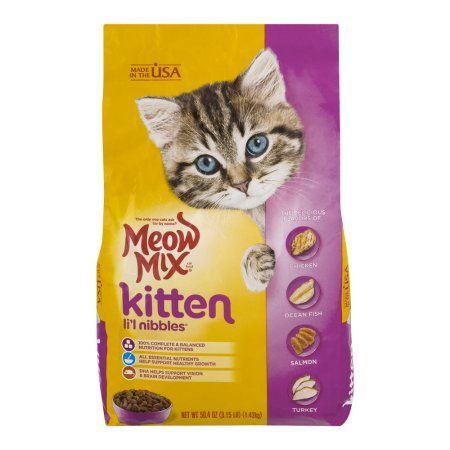
If you are feeding your kitten with a syringe or eye drop bottle, introduce food slowly. Make sure that milk does not come out of the nose, and the kitten does not choke.
If the pet began to fall asleep, and milk bubbles came out of the mouth, then he had eaten.
Stroke the kitten's belly and wipe the anus and genitals with a damp baby wipe, imitating the licking of a cat mother. This is necessary to stimulate the removal of urine and feces.
When the kitten has urinated and littered, wipe the feces and functional holes with a clean cloth and leave the kitten until the next feeding.
What not to give your kitten
0004
Fatty meat. Pork, lamb. Fatty meats are poorly digested, leading to indigestion and metabolic disorders.
Sausages . Sausages, sausages, sausages. A slice of sausage contains a lot of fat, salt and spices. The product leads to indigestion and disruption of the pancreas.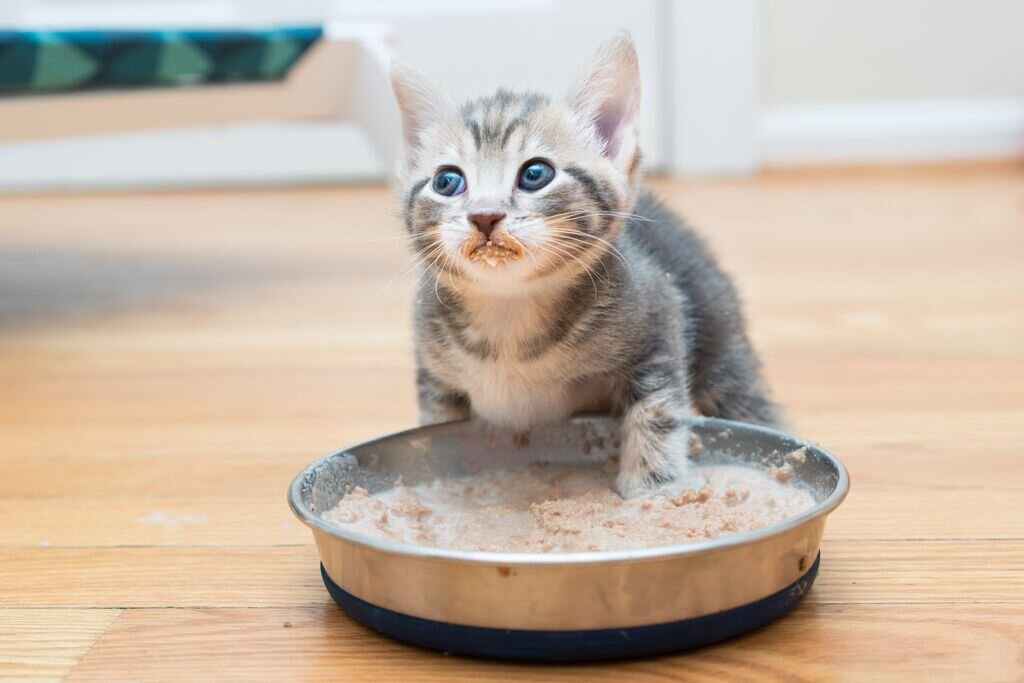
Bones . They lead to mechanical injuries of the larynx and esophagus, can cause gastric or intestinal obstruction.
Canned fish . If there are preservatives in the composition, they are not useful to the kitten.
Food from the table. Kittens do not digest salty, fried, smoked, spicy foods. Long-term complementary feeding with the remains of human food leads to a reduction in life expectancy and a number of chronic diseases that occur in old age.
Sladost i. Chocolate, sweets. Ice cream. Sharp jumps in insulin lead to the development of diabetes. Xylitol and theobromine, found in candy and chocolate, cause seizures and are toxic even to an adult cat.
Yeast dough. If you feed a kitten with bread, the animal will face bloating and colic.
Legumes . The product causes flatulence and heaviness in the stomach.
Grapes and raisins. The chemical composition of berries provokes the development of kidney failure.
The chemical composition of berries provokes the development of kidney failure.
Freshwater fish. Source of parasites and small bones capable of causing mechanical injury.
Potatoes . Ballast product with a high content of indigestible starch.
10 rules for feeding kittens
- Equip nest . Put a heating pad under the bedding and keep it clean. Newborn kittens are not able to maintain optimal body temperature on their own and are highly susceptible to viruses and infections.
- Watch your weight gain . The first 2 weeks the kitten should add 14 g daily.
- Do not cook in advance. Prepared kitten food can be stored in the refrigerator for up to 24 hours.
- Stick to the daily serving size of . If the kitten does not feel full, do not overfeed. The main indicator of satiety is a tight, but not bloated stomach.
 If the kitten does not finish eating, do not be nervous. This is due to the peculiarity of the body and appetite. Some individuals eat less.
If the kitten does not finish eating, do not be nervous. This is due to the peculiarity of the body and appetite. Some individuals eat less. - Warm food to room temperature or above (according to the age of the pet). Do not give food from the refrigerator. This can lead to vomiting and indigestion.
- Do not mix industrial and natural food and food from different manufacturers in the same bowl. This leads to an imbalance of nutrients and a serious failure of metabolic processes. Only a veterinary nutritionist can prescribe a mixed diet. And only if there are special indications.
- Introduce new ingredients gradually. Introduce new foods in small portions. To digest unfamiliar food, the body needs to produce certain enzymes.
- Do not drink whole cow's milk. Kittens do not tolerate highly concentrated lactose.
- Do not feed raw meat . Raw meat is a source of helminth eggs and viruses.
